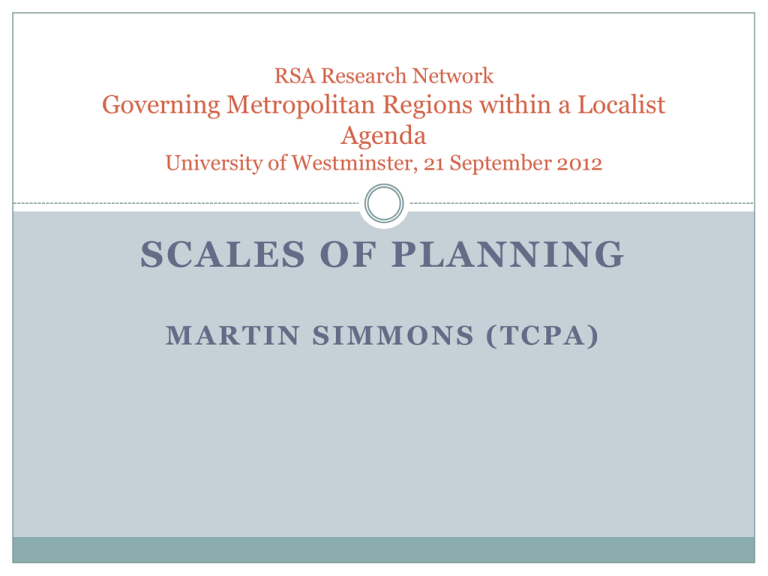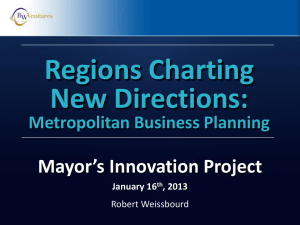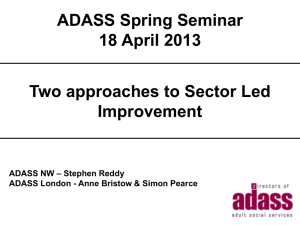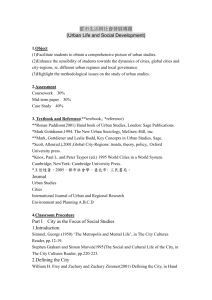Scales Of Planning - Regional Studies Association
advertisement

RSA Research Network Governing Metropolitan Regions within a Localist Agenda University of Westminster, 21 September 2012 SCALES OF PLANNING M A R TI N SI M M O N S (TC P A ) Scales of Planning: theme of presentation • The Regional Scale in England Greater London English Regions Comparisons : Paris, Berlin Situation in 2012 • The Sub-Regional Scale Conceptual: functional geographies Within London In the wider metropolitan region Rest of England: move to city-regions • The Local Authority Scale: Boroughs and Districts London: 33 LAs make Local Plans, within London Plan context In wider region: LAs make Local Plans; ‘duty to cooperate’ • Conclude: future of planning for the metropolitan region Regional Planning in England: Advantage London 1 Devolved Mayoral London continues to have its statutory London Plan 2011 Localism Act leaves London situation intact Regional Planning system introduced in 2000 being abolished Regional Spatial Strategies finalised 2007-2009: short life! Flaws: artificial regions; ‘democratic deficit’; Central Government influence (housing) and control Facilitated 2010 Government’s intent to abolish Regionalism in favour of Localism Abolition includes RSSs in the wider metropolitan region Regional Planning in England: Advantage London 2 Only administrative London now has ability to bid for strategic transport and other infrastructure investment Rest of England’s main growth region loses its voice Key upcoming issues: housing provision; airport capacity; rail capacity (commuting); water supply and management; waste Compare Paris: city related to wider Ile-de-France region - wide research/evidence-based strategies Berlin: joint Berlin-Brandenburg state planning regime functional growth geographies Sub-Regional Planning in England: towards City-Regions London: London Plan recognises 5 functional/geographic sub-regions: Central (growth); East (regeneration); North, West, South (outer London) Groupings of Boroughs > Sub-Regional Partnerships Outside London: RSSs included sub-regional policies based on functional areas or sharing common issues now: some use in Local Plan preparation (‘duty to cooperate’?) Local Enterprise Partnerships established, but effectiveness? In rest of England: move to City-Regions e.g. Greater Manchester; Greater Leeds... ‘combined authorities’ devolution starting: ‘city deals’ by Government - transport; economic development The Local Authority Scale: Boroughs and Districts 1 Contrasting situations in London & the wider metropolitan region In London 33 LAs – Boroughs – produce Borough Plans within the strategic framework of the London Plan - with which they must ‘generally conform’ An established and stable planning regime. Outside in the wider region the Boroughs and Districts prepare Local Plans With the abolition of RSSs, wider strategic issues rely on inter-LA cooperation The Local Authority scale: Boroughs and Districts 2 Localism Act ‘Duty to Cooperate’ expected to include: housing needs assessments; economic development; infrastructure including delivery For LAs to decide its scale and extent Must satisfy Examining Inspector has occurred but does ‘cooperation’ mean ‘agreement’? Present indications (early days) can work in city areas, given political will uncertain/unclear in more rural areas - including parts of the south-east outside London little sign of cooperation across the London boundary Relating London to the wider Metropolitan Region 1 The big outstanding issue London boundary set in early 1960s; retained for 2000 Mayoral regime 8 million population within biggest concentration of UK employment at centre, by far Wider functional metropolitan region extends for further 50-100 km. 10-14 million population outside; supplies 15% of London’s workforce polycentric employment structure, strongest to west No effective ability to relate together Relating London to the wider Metropolitan Region 2 Initial need is for a funded research programme - to define the real extent of the wider functional region - to assess the key linkages between London and its hinterland: migration & housing; labour markets and commuting; location of economic growth; transport, water etc. capacities; environmental challenges and green belt Alongside this, work towards a governance regime jointly to manage new forms of spatial planning - for London and the wider region as a whole - at the sub-regional scale, between four quadrants of London outwards










